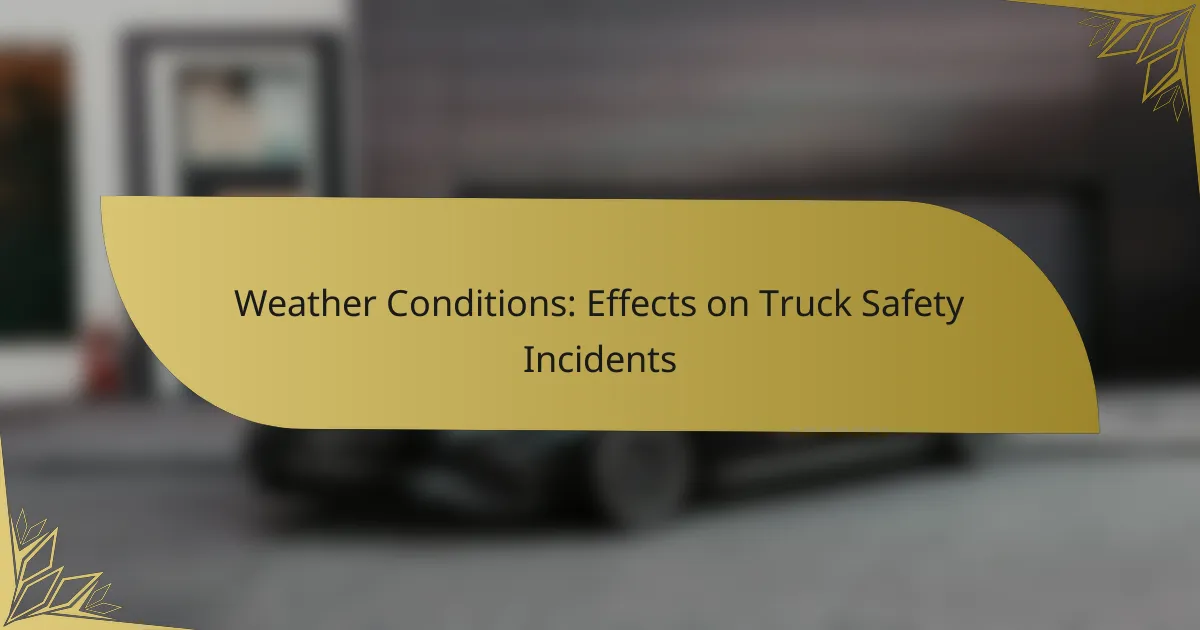Weather conditions play a crucial role in truck safety incidents, as they can drastically alter driving environments and increase the risk of accidents. Adverse weather, including rain, snow, fog, and high winds, necessitates heightened awareness and specific driving techniques to ensure safety on the road.

How do weather conditions affect truck safety incidents?
Weather conditions significantly impact truck safety incidents by altering driving conditions and increasing the likelihood of accidents. Factors such as rain, snow, fog, and high winds can create hazardous situations that require heightened awareness and adjusted driving behaviors.
Increased accident rates during rain
Rain can lead to slippery road surfaces, reducing tire traction and increasing stopping distances. Drivers should be cautious, as accident rates can rise by a substantial margin during wet conditions.
To mitigate risks, truck drivers should reduce speed, increase following distances, and use headlights to improve visibility. Regularly checking tire conditions and ensuring proper tread depth can also help maintain grip on wet roads.
Snow and ice leading to loss of control
Snow and ice create extremely dangerous driving conditions, often resulting in loss of vehicle control. Trucks are particularly susceptible to skidding due to their weight and size, making it crucial for drivers to adjust their driving techniques.
When driving in snowy or icy conditions, it is advisable to reduce speed significantly, avoid sudden maneuvers, and utilize engine braking. Keeping a safe distance from other vehicles is essential, as stopping distances can increase dramatically in these conditions.
Fog reducing visibility
Fog can severely reduce visibility, making it difficult for truck drivers to see other vehicles, road signs, and potential hazards. In such conditions, the risk of collisions increases significantly.
To navigate safely in fog, drivers should reduce speed, use low-beam headlights, and maintain a safe distance from the vehicle ahead. Utilizing fog lights, if available, can also enhance visibility without causing glare.
High winds causing vehicle instability
High winds can create instability for trucks, especially when passing through open areas or bridges. Wind gusts can push vehicles off course, increasing the risk of accidents.
Drivers should be particularly cautious when driving in windy conditions, reducing speed and being mindful of their vehicle’s load. It’s advisable to avoid driving with a high-profile load that could catch the wind, and to stay alert for sudden gusts that may affect vehicle handling.

What are the best practices for driving in adverse weather?
Driving in adverse weather requires heightened awareness and specific techniques to ensure safety. Key practices include adjusting speed, maintaining safe distances, and using the right tires for the conditions.
Adjusting speed according to conditions
Reducing speed is crucial when driving in rain, snow, or fog. Lower speeds help maintain control and reduce stopping distances, which can be significantly longer in poor weather. For instance, in heavy rain, consider reducing your speed by at least 10-20 mph below the posted limit.
Be mindful of how road conditions affect traction. Icy or snowy roads may necessitate even slower speeds, sometimes requiring reductions of 30 mph or more. Always assess the situation and adjust accordingly to maintain safety.
Maintaining safe following distances
In adverse weather, increasing your following distance is essential. A general rule is to double the standard distance; for example, if you typically maintain a three-second gap, increase it to six seconds or more. This extra space allows for more reaction time in case of sudden stops.
Wet or icy roads can lead to longer stopping distances, so be prepared for the unexpected. Regularly check your mirrors and surroundings to ensure you have ample space to maneuver safely.
Using appropriate tires for conditions
Choosing the right tires is vital for driving safely in adverse weather. All-season tires may suffice in light rain, but winter tires are recommended for snow and ice, providing better grip and handling. Ensure your tires have adequate tread depth; a minimum of 4/32 inches is advisable for wet conditions.
Regularly check tire pressure, as it can drop in colder temperatures, affecting performance. Consider using tire chains in severe winter conditions to enhance traction on icy roads. Always follow local regulations regarding tire use in adverse weather to stay compliant and safe.

How can trucking companies enhance safety during bad weather?
Trucking companies can enhance safety during bad weather by implementing comprehensive training programs, utilizing advanced weather tracking tools, and establishing clear policies that guide drivers in adverse conditions. These strategies help mitigate risks and improve overall safety on the road.
Implementing driver training programs
Driver training programs focused on bad weather conditions are essential for enhancing safety. These programs should cover techniques for handling slippery roads, reduced visibility, and other challenges posed by inclement weather. Regular refresher courses can help keep drivers aware of best practices.
Incorporating simulations of various weather scenarios can provide hands-on experience, allowing drivers to practice their skills in a controlled environment. This not only builds confidence but also prepares them for real-life situations.
Utilizing real-time weather tracking tools
Real-time weather tracking tools are crucial for trucking companies to stay informed about current and forecasted conditions. These tools can provide alerts about severe weather, enabling drivers to make informed decisions about their routes and schedules. Investing in mobile apps or GPS systems that include weather updates can be beneficial.
Additionally, integrating weather data with route planning software can help avoid hazardous areas, reducing the likelihood of accidents. Companies should ensure that drivers are trained to use these tools effectively.
Establishing clear weather-related policies
Clear weather-related policies are vital for guiding drivers during adverse conditions. These policies should outline specific actions to take when encountering bad weather, such as when to slow down, pull over, or delay travel. Having a well-defined protocol can help drivers feel more secure in their decision-making.
It’s also important to communicate these policies regularly and ensure that all drivers understand them. Regular reviews and updates to the policies can keep them relevant and effective as weather patterns change.

What technologies can improve truck safety in inclement weather?
Technologies that enhance truck safety during adverse weather conditions include advanced driver-assistance systems (ADAS), telematics for monitoring driving behavior, and weather-responsive navigation systems. These tools help drivers make informed decisions, reduce risks, and improve overall safety on the road.
Advanced driver-assistance systems (ADAS)
ADAS utilizes sensors and cameras to assist drivers in challenging weather conditions. Features like adaptive cruise control, lane-keeping assistance, and automatic emergency braking can significantly reduce the likelihood of accidents caused by poor visibility or slippery roads.
When selecting ADAS, consider systems that are compatible with your truck model and local regulations. Regular updates and maintenance are crucial to ensure that these systems function effectively, especially in inclement weather.
Telematics for monitoring driving behavior
Telematics systems track various driving metrics, such as speed, braking patterns, and acceleration, providing insights into driver behavior during adverse weather. By analyzing this data, fleet managers can identify risky driving habits and implement training programs to promote safer practices.
Investing in telematics can lead to reduced insurance costs and improved safety ratings. Ensure that the system you choose offers real-time alerts and reporting features to address issues promptly.
Weather-responsive navigation systems
Weather-responsive navigation systems provide real-time updates on road conditions, allowing drivers to adjust their routes based on current weather. These systems can alert drivers to hazards such as ice, snow, or heavy rain, helping them avoid dangerous situations.
When using these systems, ensure they are regularly updated with the latest weather data. Consider integrating them with other safety technologies to create a comprehensive safety strategy for your fleet.

What are the legal implications of weather-related truck accidents?
Weather-related truck accidents can lead to significant legal implications, including liability and insurance claims. Understanding these implications is crucial for trucking companies and drivers to navigate the aftermath of such incidents effectively.
Liability issues for trucking companies
Trucking companies may face liability issues if their drivers are involved in accidents during adverse weather conditions. Factors such as inadequate training on handling specific weather scenarios or failure to maintain vehicles can contribute to liability. Companies must ensure that their drivers are well-prepared and that vehicles are equipped for safe operation in various weather conditions.
In some cases, liability may also extend to third parties, such as maintenance contractors responsible for road conditions. If poor road maintenance contributes to an accident, these entities could share liability, complicating the legal landscape for trucking companies.
Insurance claims related to weather incidents
Insurance claims for weather-related truck accidents can vary significantly based on the circumstances of the incident. Companies should review their policies to understand coverage limits and exclusions related to adverse weather. For instance, some policies may have specific clauses addressing claims arising from severe weather events like floods or snowstorms.
When filing a claim, it is essential to document the accident thoroughly, including weather conditions at the time. This documentation can support the claim and help in negotiations with insurance providers. Companies should also be aware of the potential for increased premiums following claims related to weather incidents, which can impact overall operational costs.

How do different regions experience weather impacts on trucking?
Different regions face unique weather challenges that significantly affect trucking safety. Understanding these regional impacts is crucial for truck drivers and fleet managers to mitigate risks and ensure safe transportation.
Snowy conditions in the Midwest
In the Midwest, snowy conditions can create hazardous driving environments for truckers. Snow accumulation can reduce visibility and traction, leading to an increased risk of accidents. Drivers should be aware of local snow removal schedules and plan routes accordingly to avoid heavily affected areas.
To navigate snowy conditions safely, truckers should ensure their vehicles are equipped with winter tires and maintain a safe following distance. It is advisable to reduce speed and use low gears when driving on slippery surfaces. Regularly checking weather forecasts can help in making informed decisions about travel plans.
Heavy rainfall in the Southeast
The Southeast experiences heavy rainfall, which can lead to flooding and slick road conditions. These factors can significantly impact truck safety, increasing the likelihood of hydroplaning and reducing stopping distances. Drivers should stay updated on weather alerts and road conditions to avoid flooded routes.
When driving in heavy rain, it is essential to slow down and use headlights to improve visibility. Truckers should avoid sudden maneuvers and maintain a greater distance from other vehicles. Familiarizing oneself with local drainage patterns can help in anticipating potential flooding areas and planning safer routes.
